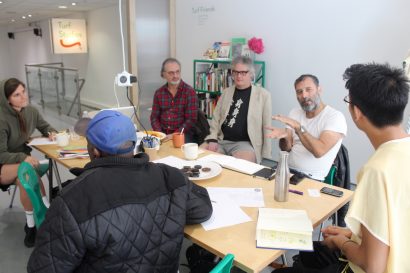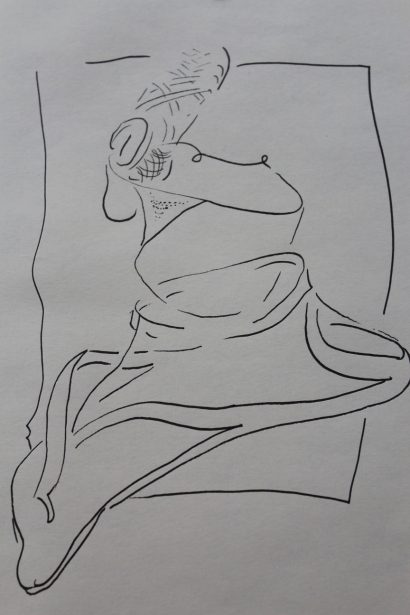- Written by Gray Wielebinski
- Feedback Sessions
GRAY WIELEBINSKI // ARTISTS’ LUNCHTIME FEEDBACK
An unofficial theme of today could be contemplating the notion of process in any practice: how does our work and the narratives we have around it function in the every day? How can we talk about and express “process” in our practices and our lives at large? In what ways are we pushed in or pressured to expedite or neatly package feelings and experiences that aren’t meant to or won’t be tidy?Can we practice getting more comfortable (as artists, as viewers, as people) with mutability and allowing ourselves and each other to be multiple things at once, to be changing, and to change our minds? What can this process look like, for ourselves, and what are some ways we can share our perpetual unfinished-ness with others? How does this affect our identities, as artists and people? How do we express our multiplicities and make room for them? Maybe this is a start!

Andy Baker volunteered to go first, and we started with his brightly colored collaged painting of a duck in the tall grass by a shimmering waterbed (admittedly dulled slightly by being presented on a screen.) Nonetheless the colors packed a punch and the conversation was equally vibrant and poignant. Formally, we discussed Andy’s balance between highly controlled techniques and setting up systems through which he can give up some control, as shown by the ink technique for the rippling water contrasted by the detailed and controlled rendering of the duck.
Stefano Montagni made an interesting comment that shed light on his existing relationship with Andy and his work through Turf, noting that he has noticed a potentially meta reference of the brills of a paintbrush in all of Andy’s works, functioning as a type of “signature”—in this work, they double as the tall grass in which the duck is nestled. This served as an accidental yet apt segue into a more personal discussion and reflection on the work.
Andy used to paint ducks, exclusively, then abruptly stopped, only to return again to the imagery after being reinvigorated by a series of coincidences involving a book cover and a postcard. With some discussion into symbolism and personal history we wonder if the duck could double as a proxy for Andy, a way of processing and expressing his emotions and himself in and through his work (which is sensitive and vulnerable in and of itself) with some distance, or protection, or space to breathe? Is this possible? Andy’s work makes us think and talk about healing and what, in practice, it looks and feels like—it’s not usually a straight line with a direct path but a process that happens every day, that little by little builds up to narratives we tell ourselves and each other. As Stefano pointed out, there’s are things in this work to zoom in and out of, that which can be read in to and that which must be taken at face value.


Francisco Zhan went next, thoughtfully displaying 5 relatively small pen and ink drawings on notebook/sketch paper on the board, and 3 more drawings, adorned in ceramic “frames,” laid out on the table as offerings. The drawings were beautiful and skillful, with perfectly loose gestures to create fully immersive scenes – chiselled Grecian figures with flowing fabrics, a campfire going out with the smoke rising to the sky, naked men in an opulent and grand setting to a zoomed in scene of insects on foliage. The room was energetic but silent as we each wandered around the works, slowly taking them in, each gravitating to certain ones that spoke to us.
Everyone seemed genuinely moved and excited about Francisco’s work, and it was truly invigorating to hear how the work touched each and every one of us in different ways, giving us each our own point of entry. The works manage to balance a seeming facileness and quickness with an obvious proficiency and strategy which results in a satisfying lightness to the work paired so strongly with thoughtfulness and intention, both in content and in concept. Describing the “haphazard” glazing technique of bronze/gold and black, white, and pastel colors and the cracked nature of the “frames” belie the thoughtfulness and intention of the works, or, as we discussed, are perhaps their exact reason for being—we discussed queerness and failure, beauty and art and ideals balanced with “reality” and labor and messiness of life (Francisco told us his drawings are usually done between clients at his massage parlor, which helps contextualize the works even further and makes me love them even more!). We discuss the works literal and conceptual relationship to Kintsugi, or “golden repair”/ “golden joinery” in Japanese, a technique in which breaks or tears are treated as part of an objects history, and ceramic cracks for example are carefully mended with gold, not only leaving the cracks visible but highlighted. Soon we discuss what it means to talk about ones work and to share it with others (and in so doing, a part of ourselves, to varying degrees), and particularly when the personal is so important to its meaning. How do we discuss queer work that is generous and open and fair, to others but also to ourselves? How much of our stories do we share when we want to be seen but also want to protect ourselves and our stories and communities? Maybe this changes from day to day, each interaction at a time. Holly Graham aptly notes that in many ways it’s in the work already.

Fernando Holguin showed us a video called “Nude Madness of Millennium Dust.” He tells us that video is a fairly new medium for him as a formally trained painter, though after viewing his paintings and watching this film video seems like a relevant and exciting new technique to expand his aesthetic and conceptual goals. The video is a black and white image, a continuous shot of a still life scene of a laptop on a well-lived in desk. We watch as (intentionally) clichéd images and quotes flash on screen amidst Fernando’s own drawings and, most notably, his own stop motion animations that move at their own pace. The work aims to deal with notions of appropriation, questions of stealing and borrowing as an artist, which avoids its potential to be entirely didactic through his clever meta motif of the screen-within-a-screen, with an absent minded hand coming in at various points to move things around and break our concentration. The work is literally and figuratively layered in so many ways and I’m grateful for and intrigued by this tool that allows for meanings to change, different places to hide and look closer, for power to shift. He collaborated with his wife who composed the music for the video, which leads to interesting questions and conversation about the role of collaboration in a life and practice, and perhaps its potential to move us beyond the binary notion of stealing or borrowing ideas? Does collaboration make us greater than the sum of our parts, or help us extend ourselves and our ideas? What if it helps us shift the narrative around identity, autonomy, genius, and theft in art and potentially allow us (at least ideally) to share, grow, experiment, learn, and overflow?

Last but not least Brian Jones showed us several watercolor works, each letter sized. Despite being technically abstract lines and brush strokes of color, we noted that many of us couldn’t help but think of nature: the sun setting over the water, each one evoking a completely different time and atmosphere. When the colors bled together it was truly magical! Brian told us he has a space upstairs in Croydon Art Store where organisation ArtHalo has studio space and he comes to paint, and we follow him there to see his favorite of his own works, and we all see why. The painting is a large scale, beautifully layered and emotive abstract work that demonstrates a real love of and understanding of color and experimentation. It is truly affective, and inspires me to consider what it could mean to be more intentional while at the same time not be afraid to let things muddle and bleed together into something entirely new, or at least entirely one’s own. I’m guessing it’s a process.
—-
Many thanks to Gray Wielebinski for leading the crit and for this writeup!
Share:
More:


Related:


- Sat Sep 29, 2018 @ 12:00
- Led by Gray Wielebinski




